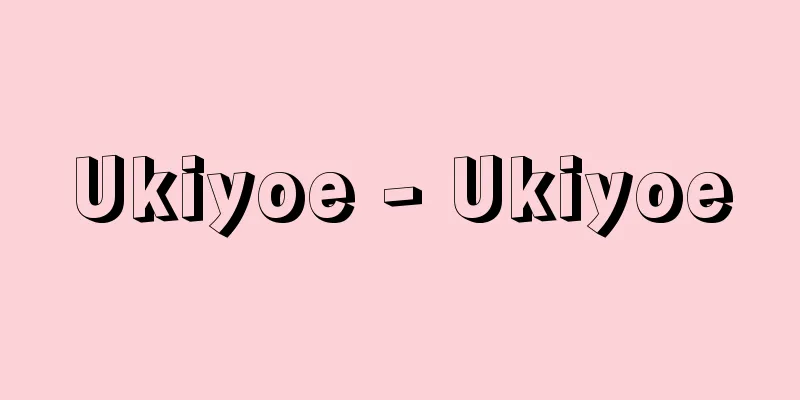Ukiyoe - Ukiyoe

|
This is a type of painting popular among the common people during the Edo period. It developed mainly in Edo, and is also called Edo-e. The origins of this style of painting can be traced back to Yamato-e, and its direct roots lie in early modern genre painting. As a style of painting for townspeople, it was opposed to the Kanō school of Chinese painting supported by the samurai, but in order to develop its style creatively, it actively absorbed and synthesized the trends of other schools of painting, including the Kanō school, the Tosa school, the Western school, and the sketch school. In order to spread cheap, high-quality paintings to the general public, woodblock prints were the main form of expression, but at the same time, hand-painted paintings were also produced, and there were ukiyo-e artists who specialized in hand-painted paintings. The neologism ukiyo-e began to take root around the Tenna period (1681-1684). The word "ukiyo" in "ukiyo-e" contains multiple meanings, such as the present world rather than the afterlife, the present which is neither the past nor the future, and the secular world with its strong aura of lust, and therefore the themes of ukiyo-e were the cutting-edge social customs of the time, particularly the customs of pleasure quarters and theater towns which were considered squalid places by the shogunate. The history of ukiyo-e can be divided into the following three periods. (1) Early Period: Meireki 3rd year to Horeki (1657-1764). (2) Middle period: Meiwa to Kansei (1764-1801). (3) Late period: Kyowa to Keio (1801-1868). [Tadashi Kobayashi] Themes of Ukiyo-eGenre paintings from the end of the Muromachi period to the Momoyama period attempted to vividly depict the manners and customs of the time across all social classes, from nobles and commoners to monks and laypeople, but soon after the Edo period began, the subjects of the paintings were limited to pleasure-seeking events in brothels. Ukiyo-e, which continued this trend, developed from the beginning with two pillars: pleasure-sex scenes in red-light districts and portraits of beautiful women, and kabuki (kabuki) and actor paintings. Portraits of beautiful women were initially limited to images of high-ranking courtesans such as tayu (courtesans), but eventually came to depict courtesans and geisha from the Okabasho (rural district), women working at teahouses, and popular town girls. Portraits of actors began with portraits of kabuki actors idealized in their performance posture, and then gave rise to caricatures that focused closely on the upper body and face. In addition, in connection with actor paintings, sumo (sumo-e) paintings were also produced, using popular sumo wrestlers as models. In addition to the portraits of popular people that served as surrogate portraits and the entertainment and customs of brothels, works depicting the daily life and customs of townspeople and samurai became noticeably more numerous, enriching the content of genre paintings. There were also many examples of portraits based on literary themes, either directly or indirectly based on Japanese and Chinese poetry, stories, or historical events. In particular, warrior paintings depicting heroic Japanese and Chinese warriors were popular throughout the ages. Illustrations for comic literature such as kibyoshi, sharebon, yomihon, and gokan were also important jobs for ukiyo-e artists. As Edo townspeople's culture matured, the subject matter became increasingly differentiated in the later period. Particularly noteworthy is the establishment and popularity of landscape painting and bird-and-flower painting, which were always the main focus of other schools of art. Landscape paintings are divided into two categories: meisho-e, which introduce the beauty of a particular place's scenery and the way of life of the people who live there, and dochu-e, which depict the scenery and customs of post stations and along the way from the perspective of a traveler. Both are characterized by humanistic depictions of landscapes that are deeply connected to human life. In bird-and-flower paintings, familiar animals and plants were chosen as the subject matter, and haiku and waka poems were added to the picture, conveying a poetic feeling of the season in a familiar way. Ukiyo-e not only provided the pure pleasure of appreciating paintings, but also functioned as a form of mass communication, conveying the latest information quickly and accurately. Examples of ukiyo-e prints that strongly incorporate news elements include shinie, portraits of famous people painted immediately after their deaths, which express tributes to them by including their achievements while they were alive and their last poems or haiku; catfish prints, which appeared immediately after the great earthquake of 1855; and Yokohama-e, which convey the state of the newly developed city of Yokohama after its port was opened. Colored illustrated newspapers, or nishikie newspapers, which were popular for a time during the Meiji period, were also a response to the demands of the times, and further strengthened and demonstrated the current affairs reporting function that ukiyo-e originally had. [Tadashi Kobayashi] formatThe main form of expression for ukiyo-e has always been woodblock prints, with hand-painted drawings playing a secondary role. Ukiyo-e prints are the product of the combined skills of the artist, the carver, and the printer, all of which were planned by commercial publishers, and the artist who provided the sketches was naturally subject to considerable restrictions on his or her expression. The history of woodblock printing in Japan is long, and since the Heian period, inbutsu (small prints made by applying ink to a printing block with a carved image of the Buddha and pressing it onto paper) and shubutsu (prints made by placing paper on a woodblock with a carved image of the Buddha and printing the back of the paper with a baren) have been made, and in the Muromachi period, woodblock picture scrolls such as "Yuzu Nembutsu Engi" (1390-1391) and woodblock Buddhist paintings such as "Twelve Devas" were actively produced. In the early modern period, prints were not only used for religious requirements and for the convenience of evangelization, but also for purely aesthetic purposes. An early example of this is the illustrations in the so-called "Sagabon" books, published by wealthy Kyoto townspeople such as Hon'ami Koetsu and Suminokura Soan from the latter half of the Keicho era (1596-1615) through the Genna era (1615-1624). The illustrations in "The Tales of Ise" (published in 1608) and "The Hyakunin Isshu" are simple sumizuri-e (ink-printed poems) in the Yamato-e style, and although technically immature, they have an elegant feel, as would be expected from works planned by first-rate townspeople intellectuals. On the other hand, apart from the extravagant Sagabon prints that sought to popularize such classical literature, illustrated editions of Otogi-zoshi and Kana-zoshi, popular publications by town publishers, also began in Kyoto, eventually spreading to Osaka and Edo, and gradually becoming more and more popular. These generally featured illustrations in ink, but the "Tanryokubon" style, which featured simple brush-coloring in a few colors such as crimson, green, and yellow, was also popular, and the tradition of enjoying literature and paintings at the same time was realized at a popular level. [Tadashi Kobayashi] The independence of Ukiyo-e printsThe demand for illustrated books for the general public in Edo was initially met by imports of Kamigata editions, but in the thriving city reconstruction following the great fire of 1657 (Furisode Fire), Edo publishers (jihon-tonya) began to print more and more books, and many hanshitaeshi (printing sketch artists) were trained. One of these, Hishikawa Moronobu (died 1694), provided excellent illustrations, mainly for kana-zoshi and erosho-hon, and expanded the proportion of illustrations in books. In other words, the text was crammed into the narrow frame of about one-fifth of the top section of the print, and the wide space below was filled with clear and elegant depictions of manners and customs, drawn with sharp lines carved with a chisel. The previous illustrated books, in which text was the primary focus and pictures were secondary, have evolved into the picture book format, in which the ratio of text to pictures is reversed. Illustrations in picture books began to supplement written expressions, but rather short sentences were added to explain the pictures. Eventually, text became unnecessary and prints for purely aesthetic purposes became independent of the book format. The earliest examples were Moronobu's works on subjects that did not require explanation of the content, such as erotic pictures (Shunga), genre pictures such as pleasure quarter guides (Yoshiwara no Tai), or well-known story pictures (Oeyama Shuten Doji). These were usually composed of a set of 12 prints, large horizontal size (approximately 27-30 cm x 36-43 cm), equivalent to two double-page spreads in a book. Ink-printed prints were the standard, but special colored prints were also produced, in which specialized artists from the workshop carefully added brushstrokes. Ukiyo-e, which started out with a horizontal screen and a format that retained vestiges of picture books, was separated into "single-sheet" prints, in which the expression was completed on a single print, by Sugimura Jihee, who was roughly the same generation as Moronobu, and his successors Torii Kiyonobu and Kiyomasu. [Tadashi Kobayashi] Ink-printed and red-paintedThe change in form that occurred with the independence of the single-sheet prints was that the size became larger, and the lines and colors were strengthened accordingly. In anticipation of a fuller expression of prints, the standard print size was enlarged to a large size (approximately 55-65 cm x 30-33 cm) by pasting a small amount (one-third to one-sixth of the entire sheet) onto a full sheet of Minogami paper. The lines became dynamic, with a rich variation in thickness and intensity, and the coloring was done with a rough brushstroke that seemed to be the laborious work of an amateur, with reddish red cinnabar (red lead) as the main color, with green and yellow used as supplementary colors. These early prints, which give a rough and strong impression, are called "tan-e," but at the same time, prints of the same design were sold as ordinary products as uncolored ink-printed prints. This painting was done between the Genroku period and the early Kyoho period (around 1690-1720). [Tadashi Kobayashi] Red and lacquer paintingIn the first year of the Kyoho era, "beni-e" (red painting) was born, replacing vermilion as the main color, and was popular until the Kanpo era (1741-1744). Beni is a bright red paint made from safflower petals, and is characterized by the clear, gentle color that is unique to vegetable dyes. To match this light color, the lines were made delicate and the brushstrokes were applied with fine detail. The print size also became smaller, with thin size (approximately 33 cm x 16 cm) becoming the standard. It is said that this beni-e style began with the idea of a publisher named Izumiya Gonshiro (Honcho Sejidanki). There is also a style of beni-e called "urushi-e" (lacquer painting) that is distinguished from other types of beni-e. This technique involves adding a lot of glue to the thick ink to give it a lacquer-like sheen, and often sprinkling brass in parts as a substitute for gold sand. All of these were ways to strengthen the painting, which tends to flow weakly. [Tadashi Kobayashi] Red printAccording to Ota Nanpo's (Shokusanjin) "Ichiwa Ichigoto," the history of brush-and-ink printmaking came to an end and color printmaking began in 1744 (Enkyo 1). Attempts at color printmaking had already been made during the Kyoho era (1716-1736) by enthusiasts of haiku poetry, for private publications such as cover art for anthologies of haiku. Finally, during the Genbun era (1736-1741), a full-scale single-piece print using the registration method was realized (Kyojitsu Bakabanashi), and the technique was immediately borrowed. Among his remaining works are a pictorial calendar from 1744 (owned by the Boston Museum of Fine Arts) and a picture of actors covering a New Year's performance at the Nakamuraza Theatre in the same year (owned by the Portland Art Museum), both of which support Nanpo's testimony. These early prints, with red and green as the main colors (in the later period, two or three more colors such as indigo and yellow were added), were called "benizurie" (red-printed pictures), and were popular for around 20 years until the Horeki era (1751-1764). The clear and refreshing colors of the vegetable-based red and green dyes were inherited from those of brush-painted beni-e, and the standard size for the prints was still narrow. In the colored prints of the second and third prints of the Benizuri-e, the coloring was still limited to symbolism, and many blank areas, including the background, were left as paper. However, multicolored prints, in which the entire surface of the picture was filled with colored areas corresponding to each design, were finally realized in 1765 (Meiwa 2). The direct impetus for this was the popularity of picture calendar exchanges that occurred in the same year, and the beautiful name "nishikie" was given to them in reference to the splendor of brocade paintings. Initially, the standard size was medium (approximately 29 cm x 22 cm), but from the Tenmei era (1781-1789) onwards, large sizes (approximately 39 cm x 27 cm) became common. To be able to withstand the pressure of repeated printing, the paper was changed from the traditional Minogami paper to thick hosho paper, and techniques such as karazuri and kime-dashi, which create unevenness in the paper without adding color, were also used. During the Kansei and Tenpo reforms, edicts were issued to control publications on a number of occasions, prohibiting extravagant multi-color printing, but the pinnacle of technique was always used for private prints and illegally published shunga. [Tadashi Kobayashi] Style historyThe history of the development of styles in ukiyo-e can also be divided into three periods, as mentioned at the beginning: early, middle, and late. There are various theories about the timing of these divisions, but here we will define them as the following three periods. (1) Early Period: The period from the great fire of the third year of the Meireki era to the Horeki era (1657-1764), when illustrations in printed books became independent of single-sheet illustrations and led to the development of the style of red-printed illustrations. (2) Middle Period: Nishikie was founded, and the classical ukiyo-e style was perfected, focusing on portraits of beautiful women and actors. From the Meiwa to the Kansei eras (1764-1801). (3) Late Period: The classical style achieved in the mid-period was further formalized, and at the same time, ukiyo-e became more popular with a diversification of themes and an increase in the number of copies published. This period marks the end of the Edo period (1801-1868) after the Kyowa period. Furthermore, even after the start of the Meiji era, ukiyo-e artists were active up until the time of the Sino-Japanese War (1894-1895), so it may be necessary to further define the final period. [Tadashi Kobayashi] initialHishikawa Moronobu, a native of Hota in Awa Province (now Chiba Prefecture), moved to Edo during the Manji and Kanbun eras (1658-1673) and joined the ranks of illustrators. He gained a reputation for depicting the customs of red-light districts, particularly pleasure quarters and theater towns, and eventually created a separate print for viewing, laying the foundations of ukiyo-e. In his Minashiguri, published in 1683, he established a unique style of portrait (beauty painting) hailed as Hishikawa-sama's Azuma Omokage. He also devoted himself to the mass production of not only prints but also hand-painted paintings, popularizing and developing commoner-style painting in Edo. After Moronobu's death, the influence of the Hishikawa school rapidly declined, and from the end of the Genroku era to the beginning of the Kyoho era, the Torii school and the Kaigetsudo school were the mainstays. The first and second Kiyomasu of the Torii school used the woodblock prints of the Tan-e period to paint heroic or elegant figures in the fields of actor paintings and beautiful women paintings, which were called "Senkenga" at the time, while Kaigetsudo Ando and his disciples mass-produced standing beauties with voluptuous figures and lavish clothing in their hand-painted paintings, reflecting the free-spirited spirit of the times. In particular, the Torii school's painting style known as "gourd-footed earthworm painting," which vividly depicts the rough acting unique to Edo Kabuki, has been followed to the present day as a unique style of actor painting. In the first half of the 18th century after the Kyoho era, during the Beni-e and Urushi-e periods, Okumura Masanobu was active as a woodblock artist, and Miyagawa Choshun was active as a hand-painted artist. Both artists added a level of delicacy to their depictions, and began to focus on conveying a poetic (literary) sentiment. Masanobu also had a wealth of planning and execution skills, as seen in his own management of the publisher Okumuraya, and was able to create new ideas for woodblock printmaking one after another, successfully keeping ukiyo-e thriving during a period of prolonged recession. For example, he was one of the earliest artists to adopt the perspective method of Western painting, developing a new genre called "uki-e," and he came up with and popularized "hashirae," which has an extremely long vertical ratio, and triptychs, which are a series of three thin panels connected horizontally. His disciples Okumura Toshinobu and Nishimura Shigenaga worked in parallel with Masanobu, and other artists such as Kiyonobu II and Kiyomasa II, who established the Torii school style, produced prolific actor paintings that garnered public support. Choshun's paintings were not limited to hanging scrolls of beautiful women standing, but included detailed depictions of manners and customs in scrolls and folding screens, making the most of the beauty of the figures and the beauty of their costumes, and setting a fine example of ukiyo-e painting that evokes the emotions of the seasons. The tradition of this school was passed on to his disciple Katsukawa Shunsho, and then to Shunsho's disciple Katsushika Hokusai, and came to form the mainstream of ukiyo-e painting, known as the Miyagawa, Katsukawa, and Katsushika schools. During the Horeki era of the Benizuri-e period, the beauty paintings of Ishikawa Toyonobu and the actor paintings of Torii Kiyomitsu were at their height, and poetic expressions of manners and customs with a strong haiku taste were popular. It was around this time that the style of Kyoto genre painter Nishikawa Sukenobu became popular, and his influence became clearly evident. [Tadashi Kobayashi] Mid-termThe founding of Nishiki-e in 1765 made Suzuki Harunobu, who played a central role in the Egoyome Exchange Society that started it all, into the most popular artist in the world of ukiyo-e. Harunobu was a colorist who made extensive use of neutral and opaque paints and displayed an exquisite sense for stable color combinations. He created works with gentle, slender-waisted men and women as emotionless as dolls as his protagonists, and he created a new style of delicate expression of customs with a romantic atmosphere by incorporating the poetic meaning of classical waka poetry into the customs of the time and by treating traditional themes as mundane. The dreamlike fictional nature of Harunobu's paintings was gradually dispelled by Isoda Koryusai, who was at the height of his power during the An'ei period (1772-1781), and it was Torii Kiyonaga in the Tenmei period (1781-1789) who liberated ukiyo-e beauties into more realistic settings. Kiyonaga's images of beauties were given the ideal proportion of eight heads, and were composed into stable groups in large-format diptychs and triptychs. During the Kansei period (1789-1801), Kitagawa Utamaro focused his gaze on the upper bodies of popular courtesans and town girls, or women of specific rank and characteristics, bringing a new style to his meticulous depictions of unique beauty and the expression of subtle psychology and emotions. Ukiyo-e bijinga (portraits of beautiful women) seems to have reached the peak of its maturity with these three masters, Harunobu, Kiyonaga, and Utamaro, and the other artists only made slight modifications to the distinctive styles of these three artists. For example, artists such as Suzuki Harushige (Shiba Kokan), who imitated Harunobu's style, Kubo Shunman, who admired Kiyonaga's style, Chobunsai (Hosoda) Eishi, Katsukawa Shuncho, and Eishosai Choki, who followed the Utamaro style, were active in parallel. Meanwhile, in the field of actor paintings, the stylized depictions of the Torii school came to be disliked as old-fashioned, and instead portrait paintings became more popular. This began with the publication of Ehon Butai Ougi (Ehon Butai Ougi), a joint work by Ippitsai Buncho and Katsukawa Shunsho, in 1770, and from the An'ei to Tenmei eras, the realism of actor paintings was improved, especially by Shunsho and his followers (Katsukawa Shun'ei, Shunko, and others). Then, in January 1794 (Kansei 6), two years after Shunsho's death, Utagawa Toyokuni released a series of full-body portraits entitled Yakusha Butai no Sugatae (Emperor's Stage Portraits), and in May, Toshusai Sharaku released a series of mica-printed large-head paintings, both of which made spectacular debuts. Toyokuni's actor paintings, which wrapped portraiture in an idealized guise, were popular with the masses, but Sharaku's paintings, which conveyed brutally realistic impressions of the real people, were not well received, and early the following year the works of this genius artist were discontinued. Actor paintings also reached a classical level of perfection during the Kansei era, when Sharaku and Toyokuni were active. Another noteworthy achievement from this period was the ukiyo-e prints by Toyoharu, the founder of the Utagawa school. Compared to the earlier ukiyo-e prints by Masanobu and others, Toyoharu's ukiyo-e prints, which had a better understanding of the perspective expression of Western paintings and depicted the natural scenery of famous places in Edo with a rich sense of reality, accustomed people to a rational visual world and greatly advanced the expression of landscapes in ukiyo-e. [Tadashi Kobayashi] Late PeriodIn the middle period, the art of beautiful women and actors, which had reached a state of perfection, continued to be a central focus of interest in the world of ukiyo-e, but stylistic developments did not appear to be new, and the decadence of maturity only deepened. In the art of beautiful women, the Utagawa school of Toyokuni, Kunisada (the 3rd Toyokuni), Keisai (Kikugawa), Eisen, and others were active, and as time went on, images of short, hunched-backed, overly lustrous beauties became the standard. The Utagawa school was also in its heyday in the art of actors, and exaggerated caricatures of the characters were popular, and actor-style art became popular not only in nishiki-e but also in picture books. Landscape painting, flower and bird painting, warrior painting, caricature, and current affairs painting such as Yokohama-e were newly opened fields to replace the stylistic development of beauties and actors. Landscape painting was started by the master Katsushika Hokusai, who resisted the trend of the heyday of the Utagawa school together with Eisen, and actively adopted Western-style expressions, and was established with the success of "Thirty-six Views of Mount Fuji" published in the first year of the Tenpo era (around 1831-1833). In 1833 (Tenpo 4), Utagawa (Ando) Hiroshige followed him and published "Fifty-three Stations of the Tokaido" (Hoeido edition), and the period of the landscape painting competition between the two continued for a while after this. The two artists' styles are in stark contrast to each other, and unlike Hokusai's severe landscapes that prioritized form, Hiroshige's landscapes are closer to reality and full of poetic charm, making them more approachable. Hokusai and Hiroshige also competed in the beauty of bird-and-flower paintings, and here too the differences in style can be seen, just as in their landscape paintings. Utagawa Kuniyoshi was the sole artist in the field of caricatures, which were full of heroic warrior pictures and satire and humor. He was also well versed in Western painting techniques and excelled in landscape painting. Kunisada, Kuniyoshi, and Hiroshige's disciples (Sadahide, Yoshikazu, and the second Hiroshige) visited the new city of Yokohama, which had just opened its port in 1859 (Ansei 6), to study Western culture and customs, pioneering a new field known as "Yokohama-e." They used Western-style expressions and vivid Western paints in addition to novel subjects, completely renewing the face of nishiki-e. In the final days of the Tokugawa shogunate, "bloody pictures" by Tsukioka Yoshitoshi and others appeared, reflecting the chaotic state of the world and the devastated hearts of the people, revealing the terminal state of ukiyo-e itself. [Tadashi Kobayashi] Influence of Ukiyo-eUkiyo-e is a type of folk painting that was a specialty of Edo, so-called minga, and it must be of the same type as Otsu-e, the hand-painted caricatures of Otsu Oiwake, Nagasaki-e, the prints depicting foreign customs in Nagasaki, and Kamigata-e, the prints featuring actors from Osaka and Kyoto. However, while the minga of other regions all focused on a specific range of subjects and only slightly evolved in style, ukiyo-e has continued to develop in a rich and diverse way for a long period of time that is incomparable. Then, after the 19th century, when the market expanded nationwide, it had a direct influence on various regions, and new minga that incorporated the robust energy of the indigenous people was created, such as the nebuta and kite paintings of Tohoku, and the daichochin-e paintings of Ekin (the artist Kinzo) of Tosa. Furthermore, from the latter half of the 19th century to the beginning of the 20th century, Japonism (Japanese taste) became popular in Europe and America, and as this trend grew, the artistic value of ukiyo-e was highly valued. At the same time, interest in ukiyo-e ware waned in Japan, where Westernization was at its height, and countless ukiyo-e prints were exported overseas throughout the Meiji period. These prints directly inspired a wide range of people, including not only painters but also literary figures, musicians, and craft designers, and they had a major influence on modern Western art movements such as Impressionism and Art Nouveau. The movement to reevaluate ukiyo-e in Japan was also a result of being influenced by this Western perception. [Tadashi Kobayashi] "Ukiyo-e Artists of Edo" by Takahashi Seiichiro (1966, Heibonsha)" ▽ "Ukiyo-e" by Kondo Ichitaro (1966, Shibundo, Japanese History New Books)" ▽ "Primary Color Japanese Art 17: Ukiyo-e" by Kikuchi Sadao (1968, Shogakukan)" ▽ "Primary Color Japanese Art 24: Genre Paintings and Ukiyo-e Artists" by Yamane Yuzo et al. (1971, Shogakukan)" ▽ "Complete Collection of Japanese Art 22: Genre Paintings and Ukiyo-e" by Kobayashi Tadashi (1979, Gakken)" ▽ "Ukiyo-e Shuka" 16 volumes and supplementary volume 2 (1978-1985, Shogakukan)" [Supplementary Material] |Narrow-sized picture of actors. 1768 (Meiwa 5). Owned by the National Diet Library . Ippitusai Buncho "Fine Art of Male Actors" National Diet Library Utagawa Kunisada "Beautiful Fan Painting, Ryogoku" It depicts a kabuki performance at the Ichimuraza Theatre in Edo, and contains a representative scene from the story in a single painting. Triptych ( Owned by the National Diet Library ) Utagawa Kuniyoshi's List of Tales of the Eight Satomi Dogs Yokohama shopping district in 1860 (Man'en 1), the year after the port opened. The Mitsui store is in the foreground on the left, and the customs office was located in Honmachi 5-chome behind it. Triptych, owned by the National Diet Library . Utagawa Sadahide's "Map of the Newly Opened Port of Yokohama along the Kanna River" A picture of Ichikawa Danjūrō VII throwing beans. Triptych owned by the National Diet Library . Utagawa Toyokuni: "The Seventh Generation of Mimasu, One of the Twelve Groups..." National Diet Library Utagawa Toyoharu "Ukie: A Procession of Daimyo" Hoeido edition, around 1835 (Tenpo 6), National Diet Library Hiroshige Utagawa, "The Fifty-three Stations of the Tokaido: Lake Hakone..." National Diet Library Hiroshige Utagawa, "Famous Places in the Eastern Capital: A View of the Zojoji Temple in Shiba" 1853 (Kaei 6), National Diet Library Hiroshige Utagawa "Illustrated Guide to Famous Places in the Sixty-odd Provinces: Echizen, Tsuruga..." Iwakiro, a brothel in Yokohama that opened in 1859 (Ansei 6). It depicts the entertainment of foreign guests, including Westerners and Chinese. Triptych, 1861 (Bunkyu 1), National Diet Library . Utagawa Yoshikazu, "Portrait of Foreigners Amusing themselves at Iwaki-ro in the Port of Yokohama's Sakae-ku..." National Diet Library Katsushika Hokusai "Kanadehon Chushingura, Act 11" National Diet Library Katsushika Hokusai's "Famous Bridges of Various Provinces: Kameido Tenjin Shrine" National Diet Library Katsushika Hokusai "New Woodblock Print: A Distant View of Shiba Atagoyama" National Diet Library Katsushika Hokusai "Hiratsuka: Fifty-three Stations of the Tokaido" National Diet Library Hokusai Katsushika's Thirty-six Views of Mount Fuji: A View of Senju Red Light District... National Diet Library Kitagawa Utamaro "Two Beauties of Iris" National Diet Library Kitagawa Utamaro's "Osome Hisamatsu: Wet Bird Umbrella" Around the Kansei era (1789-1801) Owned by the National Diet Library Kitagawa Utamaro's "Matsubaya Indoor Makeup" National Diet Library Keisai Eisen's "Oirandakaga Bi" National Diet Library Keisai Eien "48 Ukiyo Tea: Celebrating the teahouse... National Diet Library Keisai Eien: "Imasama's beautiful sights are so curious... 1863 (Bunkyu 3) National Diet Library's collection "> Tsukioka Yoshitoshi "Otsu Mii-dera Temple" 1885 (Meiji 18) National Diet Library Tsukioka Yoshitoshi "Hyakusho Kao" 1865 (Keio 1) National Diet Library Tsukioka Yoshitoshi "Hyakudan Monogatari: The Honest Rules of Niki Dan" A big picture of the actor who portrays Ichikawa Arizo (Val. Ichikawa Danjuro), who plays Takemura Sadanoshin in "Koi Yobou Dye-Died Rein." Kurobishizuri 1794 (Kansei 6), published by Tsutaya Josaburo Metropolitan Museum of Art "> Toshusai Sharaku "Takemura Sadanoshin from Ichikawa Azalea" National Diet Library 鳥居清長『美南見十二候 九月』 Painted by Ippitusai, published in 1770 (Meiwa 7), owned by the National Diet Library "Picture Book Stage Fan" (Buncho Illustration) Paintings of Katsukawa Harusho , published in the National Diet Library, 1770 (Meiwa 7) "> "Picture Book Stage Fan" (Shunsho art) Source: Shogakukan Encyclopedia Nipponica About Encyclopedia Nipponica Information | Legend |
|
江戸時代に盛行した庶民的な絵画。江戸の地を中心に発達し、別に江戸絵ともいう。絵画様式の源流は遠く大和絵(やまとえ)につながり、直接には近世初期風俗画を母胎としている。町人の絵画として、武家の支持した漢画系の狩野(かのう)派とは対立するが、様式の創造的な展開のために、その狩野派をはじめ土佐派、洋画派、写生画派など他派の絵画傾向を積極的に吸収消化し、総合していった。安価で良質な絵画を広く大衆の手に広めるために、表現形式としては木版画を主としたが、同時に肉筆画も制作しており、肉筆画専門の浮世絵師もいた。浮世絵という新造語が定着し始めるのは天和(てんな)年間(1681~1684)のころである。浮世の絵といわれたその浮世ということばには、彼岸ならぬ現世、過去でも未来でもない現在、そして好色の気味の濃い俗世間という多重の語義が込められており、したがって浮世絵の扱う主題は、当世流行の最先端の社会風俗、それも幕府から悪所とされた遊里や芝居町などの風俗が中心となった。浮世絵の歴史は以下のような3期に区分される。 (1)初期 明暦(めいれき)3年~宝暦(ほうれき)(1657~1764)。 (2)中期 明和(めいわ)~寛政(かんせい)(1764~1801)。 (3)後期 享和(きょうわ)~慶応(けいおう)(1801~1868)。 [小林 忠] 浮世絵の主題室町時代末期から桃山時代の風俗画は、貴賤(きせん)僧俗のあらゆる階層にわたって、その時様風俗を活写しようとするものであったが、江戸時代に入るとまもなく、悪所における享楽的な事象に作画の対象が限定されるようになる。そうした傾向を引き継いだ浮世絵は、当初から遊里風俗図と美人画、歌舞伎(かぶき)図と役者絵を2本の柱として展開していった。美人画は当初太夫(たゆう)など高位の遊女の画像にほぼ限られていたが、やがて岡(おか)場所の遊女や芸者、あるいは水茶屋の女、評判の町娘などまで扱うようになった。役者絵は歌舞伎役者の演技の態を理想化して描く姿絵に始まり、上半身や顔の部分に接近した似顔絵(にがおえ)を生むようになる。また役者絵との関連で人気の力士をモデルとした相撲絵(すもうえ)も行われた。以上のような人気者のブロマイドがわりの姿絵や悪所における遊楽風俗画のほかに、町人や武士の日常の生活風俗を描く作品が目だって多くなり、風俗画としての内容を豊富にしていく。人物画としてはほかに文学的主題に基づく作例も多く、日本や中国の詩歌や物語、あるいは故事などを直接題材としたり、間接的に見立てたりしている。ことに和漢の豪傑英雄を描く武者絵は時代を通じて好まれた。また、黄表紙(きびょうし)や洒落本(しゃれぼん)、読本(よみほん)や合巻(ごうかん)などの戯作(げさく)文学の挿絵も、浮世絵師の重要な仕事であった。 江戸の町人文化の成熟に伴って、後期には主題の分化が著しく進んだ。とくに際だって注目されるのは、他の画派にあってはつねに主要な関心事である風景画と花鳥画の両分野の、浮世絵における成立と流行である。風景画には、特定の土地の風光の美とそこに営まれる人々の暮らしぶりを紹介した名所絵(めいしょえ)と、旅する人の目で宿駅や道中の景観と風俗とを描いた道中絵(どうちゅうえ)の二様があり、いずれも人事と深くかかわりをもった人間くさい風景描写を特色としている。また花鳥画においても、日常身近な動植物を題材に選び、図上に俳句や和歌を賛するなどして、季節の詩感をしみじみと伝えた、親しみやすい表現がとられた。 浮世絵は純然たる絵画鑑賞の喜びを提供するばかりでなく、新鮮な情報をいち早く正確に伝達しようとするマスコミとしての機能も果たしたものである。有名人の死没の直後にその肖像を描き生前の事績や辞世の和歌や句を記して追悼の意を表した死絵(しにえ)、安政(あんせい)2年(1855)の大地震の直後に現れた鯰絵(なまずえ)、あるいは開港後の新開地横浜のようすを伝える横浜絵(よこはまえ)などは、そうしたニュース性を強く織り込んだ浮世絵版画の例である。明治期に入って一時期盛行した彩色摺(さいしきずり)の絵入り新聞、すなわち錦絵(にしきえ)新聞なども、浮世絵が本来備えていた時事報道の機能を時代の要請にこたえて一段と強化し、発揮させたものにほかならない。 [小林 忠] 形式浮世絵の主たる表現形式は終始木版画であり、肉筆画は従の関係にあった。浮世絵版画は、商業資本たる版元の企画の下に、絵師、彫師(ほりし)、摺師(すりし)三者の技術が動員された結果の産物であり、下絵を提供する絵師の表現にはおのずから相当の制約が課せられたものであった。 日本における木版画の歴史は古く、平安時代以降、印仏(いんぶつ)(仏像を彫った印版に墨を塗り紙に捺(お)す小型の版画)や摺仏(しゅうぶつ)(仏像を彫った版木の上に紙をのせ紙背から馬連(ばれん)で摺(す)る版画)がつくられ、室町時代には『融通念仏縁起』(1390~1391)のような木版絵巻や、『十二天像』ほかの木版仏画の制作が盛んに行われた。近世に入ると、そうした信仰上の要請や布教の便宜のために用いられるばかりでなく、純然たる鑑賞用としての版画が生まれることになる。その早い例が、慶長(けいちょう)年間(1596~1615)の後半から元和(げんな)年間(1615~1624)にかけて本阿弥光悦(ほんあみこうえつ)や角倉素庵(すみのくらそあん)ら京都の富裕な町衆が出版した版本、いわゆる「嵯峨本(さがぼん)」の挿絵である。『伊勢(いせ)物語』(1608刊)や『百人一首』の挿絵は、大和絵風の素朴な墨摺絵(すみずりえ)で、技術的にはなお未熟ながら、さすがに一流の町衆文化人により企画されただけに優雅な趣(おもむき)を備えるものであった。 一方、そうした古典文学を版刻普及しようとする豪華な嵯峨本とは別に、町の版元による大衆的な出版物である御伽草子(おとぎぞうし)や仮名草子の絵入り版本の刊行も、初め京都におこり、やがては大坂や江戸に広がりながら、しだいに盛んとなっていった。それらは墨摺の挿絵が普通であったが、丹(たん)と緑、黄などの数色を簡単に筆彩色(ふでざいしき)した「丹緑本(たんりょくぼん)」という形式も喜ばれ、文学と絵画の鑑賞を同時に楽しもうとする伝統が、大衆的なレベルで実現されるようになった。 [小林 忠] 浮世絵版画の独立江戸における大衆向け絵入り版本の需要は、初め上方(かみがた)版の輸入によって満たされていたが、明暦3年(1657)の大火(振袖(ふりそで)火事)以後の都市復興の活況のなかで、江戸の版元(地本問屋(じほんといや))による版行も盛んとなり、版下絵師(はんしたえし)も数多く育てられることとなった。その一人として成長した菱川師宣(ひしかわもろのぶ)(1694没)は、仮名草子や好色本を中心に優れた挿絵を提供し、本のなかに占める挿絵の比重を拡大していった。すなわち、文章は版画の上段5分の1ほどの狭い枠内に押し込められていき、下方の広いスペースには、彫刀が刻んだめりはりの強い描線による、明快でしかも優麗な風俗描写が展開されるようになる。かつての文が主で絵が従であった挿絵本(さしえぼん)から、文章と絵の比率が逆転した絵本形式へと進んだわけである。 文章表現の補完としての挿絵から、むしろ絵の説明に短文を添えさせるようになる絵本での版画は、ついには文章を不要とし、本の形式をも離れた純然たる鑑賞版画として独立するに至る。その最初期の例が、春画(しゅんが)をはじめ遊里案内などの風俗画(吉原の躰(てい))、あるいはよく知られた物語絵(大江山酒呑童子(しゅてんどうじ))など、内容の解説を要しない主題分野を扱った師宣作品で、それらは普通、本の見開き2ページ分に相当する横大判(約27~30センチメートル×36~43センチメートル)12図1組の組物(くみもの)として構成された。また墨摺絵を標準仕様としたが、工房所属の専門絵師がていねいに筆彩を加えた特別上製の彩色版画もつくられた。横長の画面でしかも組物という形式に絵本の名残(なごり)をとどめながら出発した浮世絵は、師宣とほぼ同世代の杉村治兵衛(じへえ)や後進の鳥居清信(きよのぶ)・清倍(きよます)らによって、1枚の版画のみで表現を完結する「一枚絵(いちまいえ)」に独立する。 [小林 忠] 墨摺絵・丹絵一枚絵の独立とともにおこった形式上の変化は、サイズが大型化し、それに伴って描線と彩色が強化されたことである。版画表現の充実が期待されて、標準の版型は美濃紙(みのがみ)大判の全紙にさらに若干(全紙の3分の1ないし6分の1)を貼(は)り継いだ大々判(約55~65センチメートル×30~33センチメートル)にまで拡大された。描線は肥痩(ひそう)と強弱の変化に富むダイナミックなものとなり、賦彩(ふさい)は黄色を帯びた赤色の丹(たん)(鉛丹)を主調色として緑や黄を補助的に使うだけの、素人(しろうと)の手間仕事とおぼしきいかにも粗放な筆彩色が加えられた。この荒削りで強烈な印象を与える初期版画を「丹絵(たんえ)」というが、同時に同じ図様の版画が彩色のない墨摺絵のまま並製品として売られていた。この丹絵は、元禄(げんろく)から享保(きょうほう)初年(1690~1720ころ)にかけて行われた。 [小林 忠] 紅絵・漆絵享保初年、丹にかわって主調色を紅(べに)とした「紅絵(べにえ)」が生まれ、寛保(かんぽう)年間(1741~1744)まで盛行した。紅は紅花の花弁からつくられた鮮紅色の絵の具で、植物性染料ならではの澄明感のある優しい色合いを特色とする。この軽快な色調にあわせて描線も繊細なものとなり、筆彩も細やかに施されることとなった。版型も細判(約33センチメートル×16センチメートル)が標準となり、小型化した。この紅絵は和泉屋(いずみや)権四郎という版元のくふうに始まる(本朝世事談綺(ほんちょうせじだんき))と伝えられる。また紅絵の一種で、別に区別して「漆絵(うるしえ)」とよばれる形式もある。これは、濃墨の部分に膠(にかわ)を多く加え、漆塗りのような光沢を与えたもので、さらに金砂子(きんすなご)の代用として真鍮(しんちゅう)を部分的に蒔(ま)くことが多い。これらはいずれも繊弱に流れがちな画面を強化するためのくふうであった。 [小林 忠] 紅摺絵以上の筆彩版画の歴史に終止符が打たれ、色摺の版画が行われ始めるのは、大田南畝(おおたなんぽ)(蜀山人(しょくさんじん))の『一話一言』によると、1744年(延享1)のことであった。色摺版画の試みはすでに享保年間(1716~1736)のころから、俳諧(はいかい)を趣味とする好事家たちにより、句集の表紙絵などの私的な出版物を場として行われていた。そしてついに元文(げんぶん)年間(1736~1741)には本格的な見当法による一枚絵の摺物を実現させ(虚実馬鹿語(きょじつばかばなし))、その技術がただちに借用されたのであった。遺品としては寛保4年(1744)の絵暦(えごよみ)(ボストン美術館蔵)と同年正月の中村座公演に取材する役者絵(ポートランド美術館蔵)が知られ、南畝の証言を裏づけている。この初期の紅と草(緑色)の2色を主調色とする寡色摺(かしょくずり)版画(末期には藍(あい)や黄などさらに2、3色が加わる)は「紅摺絵(べにずりえ)」とよばれ、宝暦年間(1751~1764)まで20年ほど盛行した。植物性染料の紅と草との清澄でさわやかな色感は筆彩の紅絵のそれを継承し、版型もなお細判を標準として守った。紅摺絵の二、三度摺の色摺では、なお象徴的な彩色にとどまり、背景をはじめ紙地のままに残される余白の部分も多かったが、個々の図様に応じた色面を画面の全面に充填(じゅうてん)する多色摺の版画は、1765年(明和2)にようやく実現する。同年におこった絵暦(えごよみ)交換会の流行が直接の契機となったもので、錦繍(きんしゅう)の華麗になぞらえて「錦絵(にしきえ)」の美称が命名されたのであった。当初は中判(約29センチメートル×22センチメートル)を標準のサイズとしたが、天明(てんめい)年間(1781~1789)以降は大判(約39センチメートル×27センチメートル)が一般となった。何度摺もの摺圧に耐えられるように、用紙も従来の美濃紙(みのがみ)などから厚手の奉書紙にかえられ、空摺(からずり)や、きめ出しなど、色をつけずに紙に凹凸をつける技法も活用された。寛政や天保(てんぽう)の改革時などにたびたび出版物の取締令が発せられぜいたくな多色摺が禁止されたが、私的な摺物や非合法出版の春画などでは終始、技術の粋が尽くされたのであった。 [小林 忠] 様式史浮世絵の様式発展の歴史も、冒頭に示したような、初・中・後の3期に区分される。区分の時期については諸説あるが、ここでは次の3期とする。 (1)初期 版本挿絵から一枚絵が独立し、紅摺絵版行に至るまでの様式形成期。明暦3年の大火から宝暦に至る間(1657~1764)。 (2)中期 錦絵が創始され、美人画・役者絵を中心に浮世絵様式の古典的完成の実現期。明和から寛政年間まで(1764~1801)。 (3)後期 中期に達成された古典様式の形式化が進められ、同時に主題の多様化や出版部数の増大など、浮世絵の大衆化が進行した時期。享和以降の幕末期(1801~1868)。 なお、明治年間に入ってからも日清(にっしん)戦争(1894~1895)のころまでは浮世絵系画家の活躍が盛んで、さらに終末期を別に設ける必要があるかもしれない。 [小林 忠] 初期安房(あわ)国(千葉県)保田(ほた)出身の菱川師宣が万治(まんじ)・寛文(かんぶん)年間(1658~1673)に江戸に出て挿絵画家の群に加わり、遊里と芝居町を中心とする悪所の風俗を描いて評判を得、ついに鑑賞用の版画を独立させて浮世絵の基を開いた。そして天和3年(1683)刊『虚栗(みなしぐり)』では「菱川様(よう)の吾妻俤(あづまおもかげ)」とうたわれる独自の人物画(美人画)様式を確立、版画のみならず肉筆画の量産にも力を尽くして、平民的な絵画を江戸の地に普及し、発展させた。師宣の没後は、菱川派の勢力が急激に衰え、元禄末年から享保初年にかけては鳥居派と懐月堂(かいげつどう)派が主力となって活躍した。鳥居派の初代清信と2代清倍(きよます)は、丹絵期の版画を場として当時「嬋娟画(せんけんが)」とよばれた役者絵と美人画の両分野に勇壮あるいは優麗な人物像を描き、懐月堂安度(あんど)とその門弟は肉筆画に豊満な姿態と豪奢(ごうしゃ)な着衣の立美人図を量産、闊達(かったつ)な時代精神を反映した。ことに江戸歌舞伎特有の荒事(あらごと)の演技を活写する鳥居派の「瓢箪足蚯蚓描(ひょうたんあしみみずがき)」と称される描法は、役者絵独特の描法として現代に至るまで踏襲されている。 享保年間以降の18世紀前半、紅絵、漆絵期は、奥村政信(まさのぶ)が版画の、宮川長春(ちょうしゅん)が肉筆画のそれぞれ中心画家として活躍した。ともに、描写は繊細の度を加え、詩的(文学的)情趣を伝えることに意が注がれるようになってくる。また政信は、自ら版元奥村屋を経営したように、企画力と実行力に富み、版画表現の新機軸を次々と打ち出し、長期不況の時期にあってよく浮世絵の活況を持続させた。たとえば、西洋画の透視遠近法をいち早く取り入れて「浮絵(うきえ)」という新しい分野を開発したり、画面の比率が極端に縦に長い「柱絵(はしらえ)」とか、3図分の細判を横につなげて一連とする三幅対物(さんぷくついもの)などを考案、流行させた。その弟子の奥村利信(としのぶ)、あるいは西村重長(しげなが)が政信と並行して活躍、ほかに鳥居派様式を形成化させた2代清信、2代清倍らの役者絵が一般の支持を集めて多産された。長春の肉筆画は、美人立姿の掛幅画にとどまらず、画巻や屏風(びょうぶ)に細やかな観察を行き届かせた風俗描写を展開、人物の美容と衣装の美とを尽くし、季節の情感をしみじみと盛る浮世絵肉筆画のよき範例を示した。この派の流れは孫弟子の勝川春章(かつかわしゅんしょう)、さらには春章の弟子の葛飾北斎(かつしかほくさい)へと受け継がれ、宮川、勝川、葛飾派という浮世絵肉筆画の本流を形成することになる。 紅摺絵期の宝暦年間は、美人画の石川豊信(とよのぶ)、役者絵の鳥居清満(きよみつ)が全盛で、俳趣の濃い詩的な風俗表現が好まれた。京都の風俗画家西川祐信(すけのぶ)の作風が慕われ、その影響が明らかに認められるようになるのもこのころからである。 [小林 忠] 中期1765年の錦絵の創始は、その発端となった絵暦交換会で中心的な働きをした鈴木春信(はるのぶ)を、一躍浮世絵界随一の人気絵師に仕立て上げた。春信は中間色や不透明な絵の具を多用し、安定感のある配色に絶妙の感覚を発揮した色彩画家であった。そして人形のように無表情な細腰の優しい男女を主人公として、古典和歌の詩意を時様の風俗の内にやつし、あるいは伝統的主題を平俗に見立てるなどしながら、浪漫(ろうまん)的情調の細やかな風俗表現に一風を開いた。春信画の夢幻的虚構性は、安永(あんえい)年間(1772~1781)に全盛の礒田湖竜斎(いそだこりゅうさい)がしだいに払拭(ふっしょく)し、天明年間(1781~1789)の鳥居清長(きよなが)に至って、浮世絵美人は現実的な背景のなかに解放されることになる。清長の美人画像は八頭身の理想的なプロポーションをとらされ、大判二枚続(つづき)、三枚続の大画面に、安定感のある群像として構成されるようになる。寛政年間(1789~1801)には喜多川歌麿(うたまろ)が、評判の遊女や町娘、あるいは身分、性状を特定された女性の上半身に視線を近づけ、個性的な美貌(びぼう)のきめ細かな描写や、微妙な心理や感情の表現に新風を開いている。浮世絵美人画は、これら春信、清長、歌麿の3巨匠によって成熟の頂点に達した感があり、その余の画家は三者の個性的な様式にわずかな変容を加えたにすぎない。たとえば、春信様式に倣った鈴木春重(はるしげ)(司馬江漢(しばこうかん))、清長様式を慕った窪俊満(くぼしゅんまん)、鳥文斎(ちょうぶんさい)(細田)栄之(えいし)、勝川春潮(しゅんちょう)、歌麿様式を追った栄松斎長喜(えいしょうさいちょうき)などの諸家が並行して活躍をみせた。 一方、役者絵の方面では、鳥居派の様式的描写が古様なものとして嫌われ、かわって似顔絵の風が盛んとなってくる。その端緒は明和7年(1770)刊の一筆斎文調(いっぴつさいぶんちょう)・勝川春章合筆になる『絵本舞台扇(ぶたいおうぎ)』がつくり、安永から天明年間にかけて、ことに春章とその一門(勝川春英(しゅんえい)や春好(しゅんこう)ら)を中心に役者絵の写実性が高められていった。そして春章没後2年目の1794年(寛政6)正月から歌川豊国(とよくに)が『役者舞台之姿絵』と題する全身像のシリーズを、5月からは東洲斎写楽(とうしゅうさいしゃらく)が雲母摺大首絵(きらずりおおくびえ)の連作をそれぞれ発表、華々しくデビューした。似顔表現を理想化の装いの内にくるみ込んだ豊国の役者絵は大衆的な支持を得るが、残酷なまでに実像の印象をリアルに伝えた写楽画は受け入れられず、翌年早々にはこの天才絵師の作画が中絶されてしまう。役者絵も、写楽と豊国が活躍した寛政年間に、その古典的な完成の域にまで到達したものである。 ほかにこの時期の注目すべき成果は、歌川派の開祖の豊春(とよはる)による浮絵である。政信らによる前期の浮絵よりも、いっそう西洋画の遠近表現を正しく理解し、江戸の名所の自然景を現実感豊かに表した豊春の浮絵は、人々を合理的な視覚の世界に慣れさせ、浮世絵の風景表現を大いに前進させたものである。 [小林 忠] 後期中期において完成の域に達した美人画や役者絵は、相変わらず浮世絵界の中心的な関心事であり続けたが、様式的には生新な展開をみせることはなく、爛熟(らんじゅく)退廃の度を深めるばかりであった。美人画は、豊国、国貞(くにさだ)(3代豊国)らの歌川派や渓斎(けいさい)(菊川)英泉(えいせん)らが活躍、時代が下るにつれて短躯(たんく)で猪首(いくび)、猫背(ねこぜ)の、濃艶(のうえん)にすぎる美人画像が標準となっていった。役者絵においても歌川派が全盛で、おおぎょうに誇張された似顔表現がもてはやされ、錦絵ばかりでなく絵本にも役者絵仕立(じたて)が流行した。 様式展開に行き詰まりをみせた美人画、役者絵にかわって新しく開かれた分野に風景画と花鳥画、それに武者絵や戯画、さらには横浜絵などの時事報道画があった。風景画は、歌川派全盛の時流に英泉とともに抵抗した巨匠葛飾北斎が、洋風表現を積極的に取り入れてその端緒を開き、天保初年(1831~1833ころ)に発表した『冨嶽(ふがく)三十六景』の成功により定着させた。1833年(天保4)には彼を追うように歌川(安藤)広重(ひろしげ)が『東海道五拾三次』(保永堂(ほうえいどう)版)を出し、これ以後しばらく両者の風景画競作時代が続く。両者の作風は対照的に異なり、北斎の造形性を最優先させた厳しい景観と違って、広重の風景画は現実の自然に近く詩的な情趣が横溢(おういつ)していて親しみやすい。北斎と広重は花鳥画にも妍(けん)を競い合ったが、そこでも風景画と同様の作風の差がみられる。 勇壮な武者絵や風刺と滑稽(こっけい)のユーモアを盛る戯画は、歌川国芳(くによし)の独壇場であった。彼はまた西洋画法にも明るく、風景画にも異彩を放っている。国貞、国芳、広重らの弟子(貞秀(さだひで)、芳員(よしかず)、2代広重)は、1859年(安政6)に開港の新都市横浜に洋風の文物、風俗を取材して、「横浜絵」と称する一分野を開拓、新奇な題材とともに洋風表現や鮮やかな西洋絵の具を多用するなどして、錦絵の面目を一新させた。また、最幕末には、混乱した世相と荒廃した人心を反映するような月岡芳年(つきおかよしとし)らの「血みどろ絵」も出現、浮世絵自体の末期的現象を露呈してみせた。 [小林 忠] 浮世絵の影響浮世絵は江戸特産の民俗的な絵画、いわゆる民画であり、大津追分の肉筆の戯画「大津絵(おおつえ)」や、長崎の異国風俗を扱った版画「長崎絵(ながさきえ)」、大坂や京都の役者絵を主体とした版画「上方絵(かみがたえ)」などと同類のものに違いない。しかし、他の土地の民画がいずれも、扱う主題の範囲を特定し、様式の展開も微弱な範囲にとどまったのに反して、浮世絵は、比較を絶するほどに多彩で豊かな発展を長期にわたって継続させている。そして市場を全国的に広げることになる19世紀以降には、各地に直接的な影響が及び、東北のねぶた絵や凧絵(たこえ)、あるいは土佐の絵金(えきん)(絵師金蔵)の台提灯絵(だいちょうちんえ)など、土着の民衆のたくましいエネルギーを盛り込んだ新たな民画を創生させることになる。 また、19世紀の後半から20世紀の初頭にかけてヨーロッパやアメリカでジャポニズム(日本趣味)の流行がおこり、その波の高まりのなかで浮世絵の芸術的価値が高く評価された。そのころ欧化主義全盛の日本では逆に関心が離れており、明治期を通じて無数の浮世絵版画が海外へと流出していった。それらの版画から直接刺激を受けたのは、画家ばかりでなく文学者や音楽家、工芸意匠家など広範な層にまで及び、印象主義、アール・ヌーボーなど、西洋近代の芸術運動に大きな影響を与えている。日本における浮世絵再評価の動きも、こうした欧米の認識に教えられた結果のものであった。 [小林 忠] 『高橋誠一郎著『江戸の浮世絵師』(1966・平凡社)』▽『近藤市太郎著『浮世絵』(1966・至文堂・日本歴史新書)』▽『菊地貞夫著『原色日本の美術17 浮世絵』(1968・小学館)』▽『山根有三他著『原色日本の美術24 風俗画と浮世絵師』(1971・小学館)』▽『小林忠著『日本美術全集22 風俗画と浮世絵』(1979・学習研究社)』▽『『浮世絵聚花』16巻・補巻2(1978~1985・小学館)』 [補完資料] |細判役者絵。1768年(明和5)国立国会図書館所蔵"> 一筆斎文調『男形役者細絵』 国立国会図書館所蔵"> 歌川国貞『美人団扇絵 両国』 江戸・市村座で上演された歌舞伎を描いたもので、物語の代表的な場面が一枚の絵に収められている。三枚続国立国会図書館所蔵"> 歌川国芳『里見八犬伝一覧』 開港翌年、1860年(万延1)の横浜商店街。左手前は三井店、その奥の本町5丁目に運上所があった。三枚続国立国会図書館所蔵"> 歌川貞秀『神名川横浜新開港図』 7世市川団十郎豆まきの図。三枚続国立国会図書館所蔵"> 歌川豊国『十二組の内 七代目三舛の豆ま… 国立国会図書館所蔵"> 歌川豊春『浮絵 御大名行列之図』 保永堂版 1835年(天保6)ころ国立国会図書館所蔵"> 歌川広重『東海道五拾三次之内 箱根 湖… 国立国会図書館所蔵"> 歌川広重『東都名所 芝増上寺山内ノ図』 1853年(嘉永6)国立国会図書館所蔵"> 歌川広重『六十余州名所図会 越前 敦賀… 1859年(安政6)開業の横浜の遊女屋岩亀楼。西洋人や中国人などの外人客の遊興のさまが描かれている。三枚続 1861年(文久1)国立国会図書館所蔵"> 歌川芳員『横浜港崎廓岩亀楼異人遊興之図… 国立国会図書館所蔵"> 葛飾北斎『仮名手本忠臣蔵 十一段』 国立国会図書館所蔵"> 葛飾北斎『諸国名橋奇覧 かめいど天神た… 国立国会図書館所蔵"> 葛飾北斎『新板浮絵 芝愛宕山遠見之図』 国立国会図書館所蔵"> 葛飾北斎『東海道五十三次 平塚』 国立国会図書館所蔵"> 葛飾北斎『冨嶽三十六景 従千住花街眺望… 国立国会図書館所蔵"> 喜多川歌麿『あやめ二美人』 国立国会図書館所蔵"> 喜多川歌麿『お染久松 濡乙鳥塒傘』 寛政年間(1789~1801)ごろ国立国会図書館所蔵"> 喜多川歌麿『松葉屋内粧ひ』 国立国会図書館所蔵"> 渓斎英泉『おいらんだかが美』 国立国会図書館所蔵"> 渓斎英泉『浮世四十八手 茶屋にまつやく… 国立国会図書館所蔵"> 渓斎英泉『今様美人拾二景 気がかるそう… 1863年(文久3)国立国会図書館所蔵"> 月岡芳年『御上洛東海道 大津三井寺』 1885年(明治18)国立国会図書館所蔵"> 月岡芳年『月百姿 高雄』 1865年(慶応1)国立国会図書館所蔵"> 月岡芳年『和漢百物語 仁木弾正直則』 『恋女房染分手綱』で竹村定之進を演じる市川鰕蔵(5世市川団十郎)を描く役者大首絵。黒雲母摺 1794年(寛政6年) 版元蔦屋重三郎メトロポリタン美術館所蔵"> 東洲斎写楽『市川鰕蔵の竹村定之進』 国立国会図書館所蔵"> 鳥居清長『美南見十二候 九月』 一筆斎文調画 1770年(明和7)刊国立国会図書館所蔵"> 『絵本舞台扇』(文調画) 勝川春章画 1770年(明和7)刊国立国会図書館所蔵"> 『絵本舞台扇』(春章画) 出典 小学館 日本大百科全書(ニッポニカ)日本大百科全書(ニッポニカ)について 情報 | 凡例 |
<<: Ukiyo-e Study - Ukiyo-e Study
>>: Floating business - Ukiyaku
Recommend
Alkmēnē (English spelling) Alkmene
…Zeus also fathered many children with mortal wom...
Aizen-ko
〘Noun〙① Buddhist term. A Buddhist ceremony held to...
Kazkaz
…The North Caucasus is part of the Russian Federa...
De Roburt, H.
… [Politics, Economy] The parliament is unicamera...
Corella japonica
Phylum Protochordata, Subphylum Urochordata, Class...
Alpha Ridge
…The names of the landforms and the depths of the...
Year-end sweetfish - Etsunen ayu
...This state is called "rust" and they...
Marcel Florkin
1900‐1979 Belgian biochemist. Born in Liège, he st...
Pleural cavity
The part of the thoracic cavity excluding the medi...
Pressure (barometric) gradient
The rate at which atmospheric pressure changes ove...
PAR - Partial Apparent
Abbreviation for 4-(2-pyridylazo)resorcinol. C 11...
Kobe University
A national university corporation. In 1949, Kobe ...
Rhenium oxide - Sankarenium
The oxides of rhenium with the oxidation states IV...
Boroboronoki - tattered tree
A deciduous tree of the family Ardisiaceae (APG c...
Auscultation
A diagnostic method that uses a stethoscope to lis...









